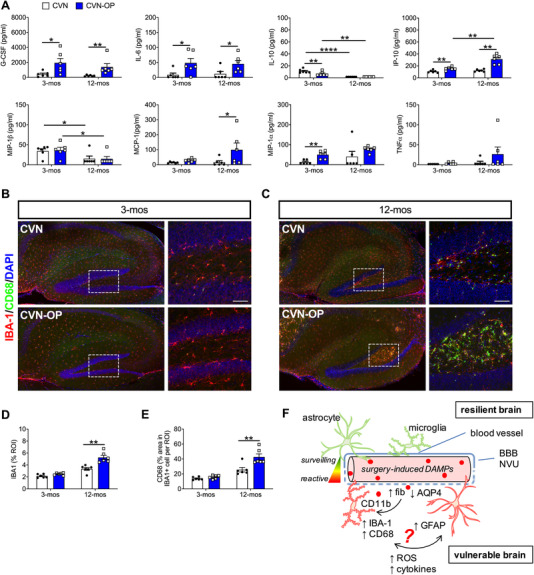FIGURE 1.

Age‐dependent inflammatory changes after orthopedic surgery in CVN‐AD mice. A, Systemic inflammatory markers in plasma from 3‐ and 12‐month‐old CVN naïve (CVN) and operated mice (CVN‐OP) 24 hours after surgery. B, Hippocampal neuroinflammation in 3‐month‐old CVN‐AD mice. The large field images were processed at 20× magnification and stitched. C, Hippocampal neuroinflammation in 12‐month‐old CVN‐AD mice. D‐E, Quantification of Iba‐1 and CD68 immunoreactivity failed to show significant changes in microglial morphology in 12‐ month‐old CVN‐AD. Inset represents the dentate gyrus (DG). F, Schematic representation of putative mechanisms of age‐depended neuroinflammation and associated blood‐brain barrier/neurovascular unit (BBB/NVU) dysfunction. In the CVN‐AD adult brain the BBB is not affected by surgical trauma associated molecular patterns (STAMPs), thus resulting in no evident morphological changes in glia cells. However, older CVN‐AD mice are “primed” and microglia respond greatly to STAMPs, including fibrinogen (see Figure 2), possibly inducing reactive astrocytes and initiating a vicious cycle that perpetuates neuroinflammation and neurotoxicity. Results are shown as mean ± standard error of the mean, n = 6/group for both 3‐ and 12‐month‐old CVN mice. **** P < .0001, **P < .001, ** P < .01, * P < .05, as measured by two‐way analysis of variance with Tukey's test for multiple comparison. Scale bar = 50 µm
